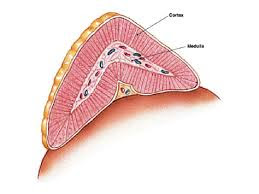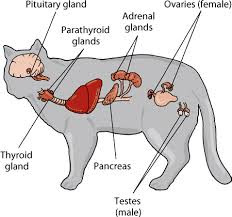
Feline Body Parts – The Adrenal Glands of a Cat
Body Parts – the Adrenal Glands
I would venture that most people have heard of the adrenal glands. I would also bet that if asked about what the adrenals do, most folks would correctly guess that they make adrenaline, the “fight or flight” hormone that makes your heart race before that first big plunge on the roller coaster. But the adrenals do so much more than just make adrenaline. These small glands are impressive little hormone factories, producing substances that control electrolytes, influence blood pressure, manage stress, and help regulate blood sugar.
The adrenals, as their name implies (from the Greek: ad = on top of, renal = kidney) are located just above each kidney. The gland is comprised of two parts, the outer portion, called the cortex, and the inner portion, the medulla.
 The cortex can be subdivided even further, into three layers. Each later produces different hormones. The outermost layer produces aldosterone, a hormone that controls blood pressure by adjusting the level of sodium and potassium in the body. The middle layer produces cortisol, a steroid hormone that regulates metabolism and helps the body manage physiologic stress. The inner layer produces sex hormones such as estrogen and progesterone, (although the majority of the sex hormones come from the ovaries and testes.)
The cortex can be subdivided even further, into three layers. Each later produces different hormones. The outermost layer produces aldosterone, a hormone that controls blood pressure by adjusting the level of sodium and potassium in the body. The middle layer produces cortisol, a steroid hormone that regulates metabolism and helps the body manage physiologic stress. The inner layer produces sex hormones such as estrogen and progesterone, (although the majority of the sex hormones come from the ovaries and testes.) The medulla is where adrenaline (also known as epinephrine) is manufactured by the body. As mentioned above, this hormone helps the body spring into action in an emergency by increasing heart output and blood pressure, and raising the blood sugar.
Fortunately, cats are much less susceptible to adrenal disorders compared to dogs. Many veterinarians forget to even put adrenal disorders on their list of possibilities when dealing with cats, causing these ailments to be underdiagnosed in cats. The three most common of these uncommon conditions are Cushing’s disease, Addison’s disease, and Conn’s disease.
 Cushing’s disease (the proper name is hyperadrenocorticism) is a condition in which the adrenal gland is producing too much cortisol. There are two main reasons for this: either the pituitary gland is telling the adrenals to make more cortisol than it should, or there’s a tumor of the adrenal gland that is producing cortisol uncontrollably. In cats, the pituitary is the culprit 80% of the time. Cortisol-secreting adrenal tumors in cats are very rare. The main signs of feline Cushing’s disease are excessive thirst and urination, weight loss despite a voracious appetite, a pot-bellied appearance, hair loss, and thin papery skin. Diagnosis is made by special blood tests and imaging techniques like ultrasound or CT scanning. There are medications that can be given to control cortisol secretion from the adrenals, however, if an adrenal tumor is the cause of the condition, surgical removal of the tumor might offer the best chance of treatment.
Cushing’s disease (the proper name is hyperadrenocorticism) is a condition in which the adrenal gland is producing too much cortisol. There are two main reasons for this: either the pituitary gland is telling the adrenals to make more cortisol than it should, or there’s a tumor of the adrenal gland that is producing cortisol uncontrollably. In cats, the pituitary is the culprit 80% of the time. Cortisol-secreting adrenal tumors in cats are very rare. The main signs of feline Cushing’s disease are excessive thirst and urination, weight loss despite a voracious appetite, a pot-bellied appearance, hair loss, and thin papery skin. Diagnosis is made by special blood tests and imaging techniques like ultrasound or CT scanning. There are medications that can be given to control cortisol secretion from the adrenals, however, if an adrenal tumor is the cause of the condition, surgical removal of the tumor might offer the best chance of treatment. Addison’s disease (hypoadrenocorticism) is basically the opposite of Cushing’s disease. In this condition, the adrenal gland is making an inadequate amount of hormones. In most cases, the adrenal produces insufficient aldosterone and insufficient cortisol. In some cases, however, the adrenal produces inadequate cortisol only. This is known as “atypical” Addison’s disease. Clinical signs of the disorder are non-specific and include poor appetite, lethargy, weakness, vomiting, and diarrhea. Routine bloodwork may suggest the presence of Addison’s disease, however, a special blood test, called an ACTH stimulation test, is necessary for a definitive diagnosis. Treatment requires administration of the deficient hormones.
Addison’s disease (hypoadrenocorticism) is basically the opposite of Cushing’s disease. In this condition, the adrenal gland is making an inadequate amount of hormones. In most cases, the adrenal produces insufficient aldosterone and insufficient cortisol. In some cases, however, the adrenal produces inadequate cortisol only. This is known as “atypical” Addison’s disease. Clinical signs of the disorder are non-specific and include poor appetite, lethargy, weakness, vomiting, and diarrhea. Routine bloodwork may suggest the presence of Addison’s disease, however, a special blood test, called an ACTH stimulation test, is necessary for a definitive diagnosis. Treatment requires administration of the deficient hormones. Conn’s disease (hyperaldosteronism) is an adrenal disorder in which the adrenal cortex produces excessive amounts of the hormone aldosterone. It is the most common adrenal disorder in cats. [Note: the other two feline adrenal disorders are commonly referred to by their eponyms, Cushing’s and Addison’s. For some reason though, hyperaldosteronism is rarely called Conn’s disease in veterinary medicine. Convention, I suspect.] Excessive aldosterone will cause the blood sodium level to rise and the potassium level to drop. This can lead to dangerously high blood pressure as well as severe muscle weakness. The most common cause is a tumor of the adrenal gland. In cats, about half of these tumors are benign, and half are malignant. Routine blood tests may be suggestive of hyperaldosteronism, but a definitive diagnosis often requires measurement of aldosterone levels in the bloodstream as well as some form of diagnostic imaging, such as ultrasound or a CT scan, to better assess the adrenals. Treatment can be either medical or surgical. Surgical removal of the adrenal tumor can potentially cure the condition, however, surgery isn’t always an option either due to cost, anesthetic risk to the cat, or invasion of the tumor into the vena cava (a major blood vessel) making surgery too dangerous. For cats that are poor candidates for surgery, medical management is recommended. This involves controlling the blood pressure with a drug called amlodipine, administering another drug called spironolactone which counteracts the effects of the aldosterone, and supplementing the diet with extra potassium, so as to maintain a normal blood potassium level. The dosages of these drugs may need to be increased as the disease progresses over time. If the tumor has not spread and it can be completely removed, the prognosis is excellent. Cats undergoing medical management may do well for many months or even years, as long as they receive their medication and are monitored closely.

